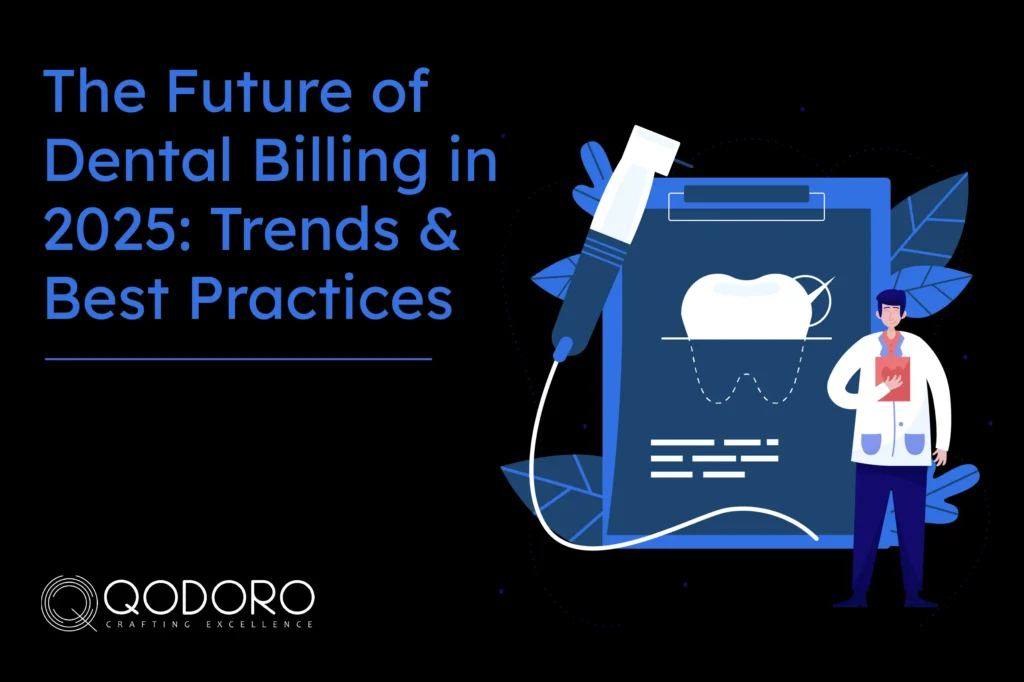
Published on: 25/03/2025

SHARE
The dental industry is undergoing a significant transformation, driven by technological advancements, regulatory shifts, and evolving patient expectations. As we move into 2025, the dental billing landscape is rapidly advancing, with automation, AI-powered solutions, and enhanced compliance measures at the forefront. The push for efficiency, accuracy, and seamless patient experiences is fundamentally reshaping revenue cycle management for dental practices.
Recent industry reports highlight a major shift: over 60% of dental practices in the U.S. are projected to adopt AI-driven billing solutions by 2025, significantly reducing claim denials and expediting reimbursements. Additionally, with dental billing guidelines evolving and insurance providers tightening policies, compliance is becoming more complex- forcing dental offices to stay proactive to avoid financial setbacks.
The financial stakes are high- studies show that billing errors contribute to over $20 billion in lost revenue across the healthcare industry annually, and the dental sector is no exception. Practices that fail to modernize risk falling behind, as new technologies and best practices set the standard for success.
This article delves into dental industry predictions for 2025, key trends in future dental billing services, and the essential best practices that will define financial success in the coming year.
The dental billing industry is on the cusp of a major transformation, fueled by advancements in artificial intelligence, regulatory shifts, and evolving patient expectations. With increasing automation, cloud-based solutions, and a greater focus on compliance, dental practices must stay ahead to optimize revenue cycle management. Studies show that nearly 70% of dental offices plan to integrate AI-powered billing systems by 2025, significantly reducing administrative burdens and improving financial outcomes.
Moreover, the global dental billing software market is projected to grow at a CAGR of 10.5% over the next five years, reflecting the rapid digitalization of the industry. As technology and industry standards evolve, understanding these key trends will be crucial for dental practices aiming for success in 2025 and beyond.
Artificial intelligence and machine learning are revolutionizing the dental billing landscape. Automated billing systems can now analyze claim data, detect potential errors, and ensure compliance before submission. Studies indicate that AI-driven billing solutions can reduce claim rejection rates by up to 50%, significantly improving cash flow for dental practices.
Automation also streamlines dental billing training, helping staff become proficient in navigating complex insurance processes without extensive manual oversight. AI-powered chatbots and virtual assistants are expected to play a more prominent role in handling routine billing inquiries, freeing up administrative staff for higher-value tasks.
As insurance policies evolve, staying compliant with dental billing guidelines is becoming more challenging. The American Dental Association (ADA) and other regulatory bodies are continuously updating coding standards, requiring practices to stay vigilant in maintaining compliance. Failure to adhere to new regulations can result in penalties, delayed reimbursements, and legal complications.
To navigate these changes, many practices are turning to dental billing consulting professionals who specialize in compliance and risk management. Outsourcing billing functions to experts helps mitigate risks and ensures adherence to the latest industry standards.
Managing insurance verification in-house requires dedicated staff, ongoing training, and constant updates on changing insurance policies. This places a heavy burden on front-desk teams who already juggle multiple responsibilities.
By outsourcing this process, dental offices free up internal staff, allowing them to focus on essential tasks such as scheduling, patient engagement, and treatment planning rather than insurance-related complexities. Reports indicate that front-office staff spend up to 25% of their work hours on insurance verification time that could be better utilized for patient care.
Additionally, fewer administrative errors mean less time spent on resubmitting claims, calling insurance companies for clarifications, and dealing with frustrated patients who receive unexpected bills. This improved efficiency leads to a smoother patient experience and a more productive workforce.
Adapting to the evolving dental billing landscape requires more than just new technology- it demands a shift in mindset, processes, and team engagement. As automation and regulation continue to reshape workflows, dental practices that adopt clear, proactive billing strategies will see faster reimbursements, lower claim denials, and improved patient satisfaction.
The foundation of a well-functioning billing system lies in your team’s knowledge. With CDT codes being updated annually and insurance providers frequently revising their policies, consistent training is critical. Regular workshops or online modules can help staff stay informed, reduce costly coding errors, and ensure compliance with billing regulations.
One of the most effective ways to reduce patient disputes and last-minute billing issues is by verifying insurance eligibility in real-time before the appointment. Tools that integrate directly with practice management software can automatically pull plan details, co-pays, and coverage levels, helping your team set accurate expectations and avoid claim denials due to ineligibility.
Many practices lose revenue due to slow follow-ups on denied or aging claims. Implementing AI-driven claim management tools allows for automatic tracking, flagging of rejected claims, and timely resubmission. This automation ensures no claims fall through the cracks and increases your practice’s collection rate substantially.
Billing doesn’t end at submission- it includes clear, patient-friendly communication. Offering mobile-friendly billing portals, flexible payment plans, and SMS or email reminders can drastically improve collection times. According to InstaMed, 74% of patients prefer to pay medical bills online, highlighting the need for intuitive digital payment options that match modern expectations.
As dental practices face increasing billing complexity, staffing challenges, and time constraints, outsourcing billing services has emerged as a smart strategic move, especially for growing practices and multi-location clinics. Outsourcing provides instant access to a team of trained billing professionals, certified coders, and industry-compliant software, without the expense of hiring and maintaining an in-house billing department. For many practices, this translates to faster processing times, fewer errors, and better collections. A 2024 industry survey revealed that practices using outsourced billing reported a 15–30% increase in monthly collections within the first six months.
Navigating evolving insurance policies and regulatory compliance can be overwhelming. Dental billing companies specialize in keeping up with ADA coding updates, payer policy shifts, and HIPAA guidelines. This ensures your practice stays protected from fines, delays, and legal risks while maintaining accuracy in every claim.
As your patient volume increases, outsourcing provides the ability to scale without increasing your in-house administrative team. Whether you’re expanding to new locations or integrating new specialties, an experienced dental billing partner can adjust workflows seamlessly to match your growth.
Outsourced dental billing services often operate across multiple time zones or offer around-the-clock support, allowing claims to be submitted, tracked, and followed up on without delay. This can significantly improve turnaround time, especially for practices with high claim volumes or extended patient hours. According to a 2023 Dental Intelligence report, practices that leveraged 24/7 billing support saw an average 18% improvement in claim approval speed.
When billing responsibilities are shifted off the shoulders of internal staff, clinical teams are freed up to concentrate on enhancing patient care, reducing front-desk burnout, and improving patient satisfaction. A study by the ADA found that front-office teams spend up to 35% of their time handling billing-related tasks- time that could be redirected toward patient communication, scheduling, or treatment planning when outsourcing is in place.
Most outsourced billing partners offer access to real-time dashboards and in-depth revenue cycle analytics. These tools provide actionable insights on collection rates, aging claims, common denial reasons, and reimbursement trends. This level of transparency enables dental practices to pinpoint inefficiencies and make data-driven improvements. Practices that adopted outsourced billing with integrated analytics tools reported a 25% increase in net collections within six months, according to HFMA.
Hiring, training, and retaining an in-house billing team can be expensive, especially for growing practices. Outsourcing eliminates costs related to payroll, benefits, software licenses, and continued education. According to Dental Economics, practices save an average of ₹5–7 lakhs annually by outsourcing billing compared to maintaining a full-time in-house billing department, while still gaining access to a broader range of expertise and scalable support.
As we move into 2025, dental billing is no longer just an administrative necessity- it’s a strategic pillar that directly impacts a practice’s profitability, reputation, and long-term viability. With increasing complexities in insurance policies, evolving ADA codes, and heightened patient expectations, relying on outdated or manual billing processes is no longer sustainable.
The integration of AI, automation, and cloud-based platforms is reshaping how dental practices handle claims, communicate with patients, and maintain compliance. Practices that adopt these technologies are already seeing benefits such as faster reimbursements, reduced denial rates, and more streamlined workflows. At the same time, the growing demand for transparency and personalization in billing experiences is pushing providers to rethink how they engage with patients financially.
For many practices, especially those scaling or juggling resource constraints, outsourced dental billing services offer a cost-effective, expertise-rich solution. By offloading complex tasks to professionals who specialize in revenue cycle management, dental teams can focus on what they do best- delivering excellent care.
AI-driven automation, real-time insurance verification, cloud-based billing systems, and stricter compliance protocols are leading the future of dental billing.
AI reduces manual errors, automates claim tracking and resubmission, improves coding accuracy, and helps practices detect billing issues before submission, boosting revenue cycle efficiency.
If you’re struggling with high denial rates, staffing challenges, or slow collections, outsourcing can provide access to experienced professionals, reduce costs, and increase reimbursement speed.

